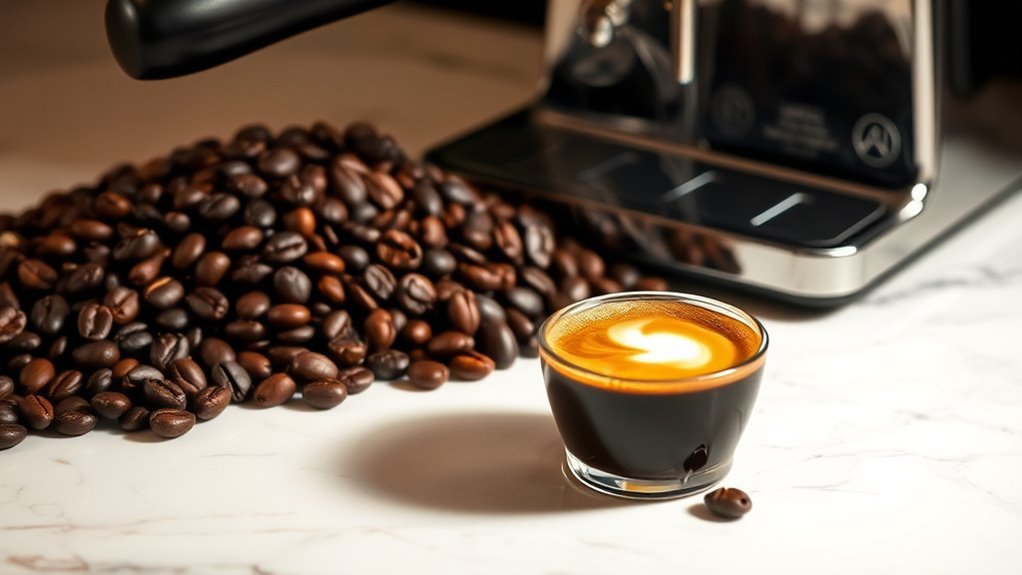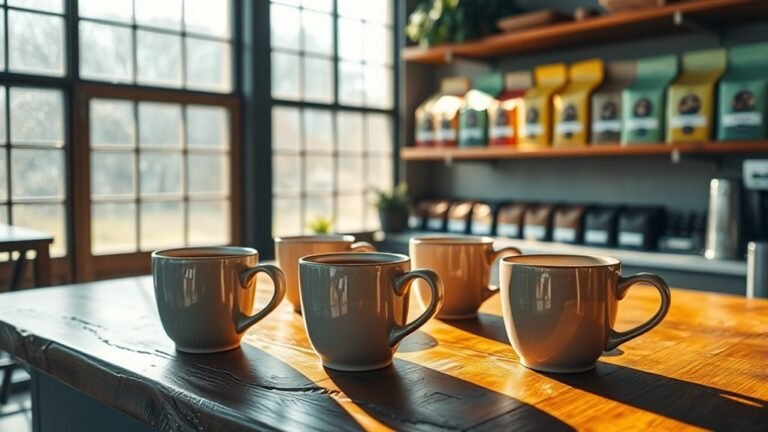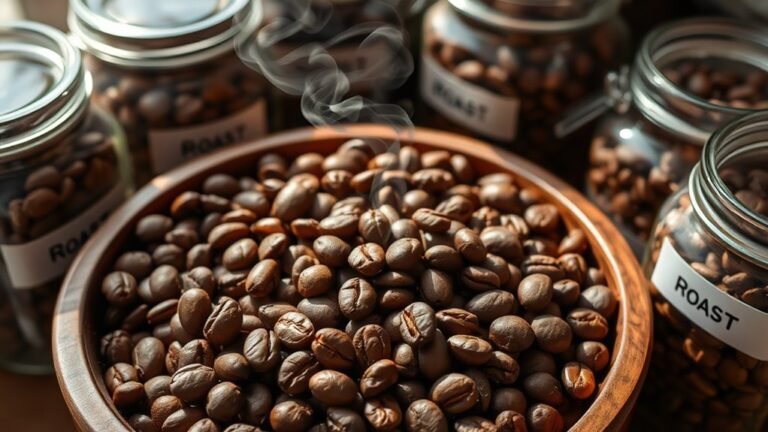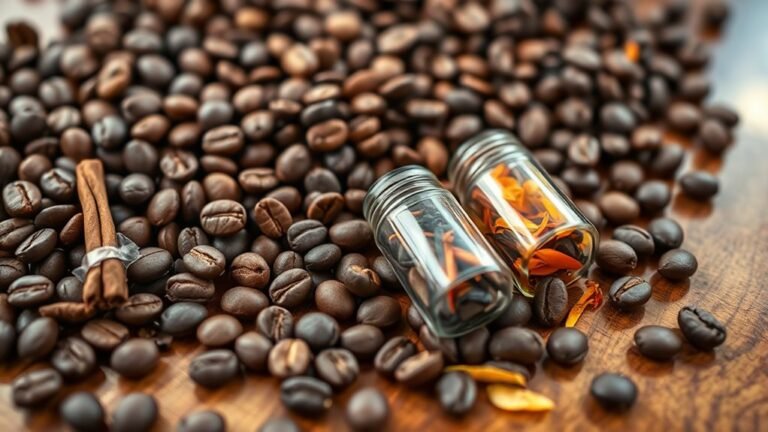The Best Coffee for Espresso
For the best coffee for espresso, choose freshly roasted beans—preferably within two weeks—to preserve rich oils and bold flavors. Medium to dark roasts provide a balanced profile with smoky, chocolatey, and fruity notes. Arabica beans offer smoother, nuanced tastes, while blends mixing Arabica and Robusta enhance crema and strength. Grind just before brewing for peak extraction and use airtight storage to maintain freshness. Explore these elements closely, and you’ll reveal even more ways to perfect your espresso craft.
Understanding Espresso Coffee Beans
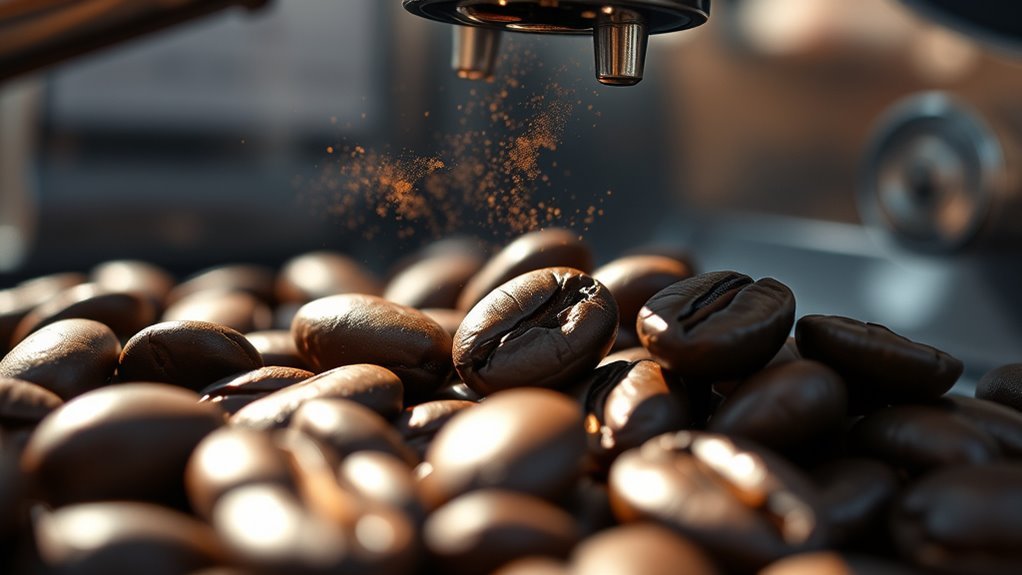
Although espresso is often associated with a specific brewing method, understanding the coffee beans themselves is vital to mastering the art. You need to recognize that the quality, roast level, and grind size of your beans directly impact espresso extraction. Selecting beans with a balanced profile allows you to access nuanced flavors during brewing techniques tailored to your taste. Whether you prefer a lighter or darker roast, the bean’s origin and freshness play important roles. By mastering these elements, you gain the freedom to experiment beyond standard espresso norms, crafting shots that reflect your personal style. Knowing your beans empowers you to control extraction variables precisely, ensuring every espresso you pull delivers rich complexity and satisfying intensity, making your coffee experience truly your own.
Arabica vs. Robusta for Espresso
When choosing between Arabica and Robusta for your espresso, you’ll notice distinct flavor profiles—Arabica offers a smoother, more nuanced taste, while Robusta packs a stronger, more bitter punch. You’ll also find that Robusta contains nearly twice the caffeine of Arabica, which can impact both the intensity and crema of your shot. Understanding these differences helps you tailor your espresso to match your taste and energy needs perfectly.
Flavor Profiles Comparison
Because your choice between Arabica and Robusta beans can dramatically shape your espresso experience, it’s crucial to understand their distinct flavor profiles. Arabica offers a smoother, more nuanced flavor intensity with vibrant tasting notes like fruity, floral, and sweet undertones. It’s perfect if you crave complexity and subtlety in every shot. Robusta, on the other hand, delivers a bolder, earthier punch with a stronger bitterness and chocolatey, nutty tasting notes. It’s ideal when you want a powerful, full-bodied espresso with a robust crema. Knowing these differences lets you tailor your espresso to your mood and freedom of taste—whether you prefer a delicate dance of flavors or an intense, straightforward kick. Your espresso journey depends on embracing these flavor nuances.
Caffeine Content Differences
While flavor profiles shape your espresso’s character, caffeine content plays a crucial role in its impact and appeal. Arabica beans typically contain less caffeine—about 1.2%—compared to Robusta’s 2.2%. If you crave a bold jolt, Robusta’s higher caffeine absorption can deliver a stronger kick, perfect for those with lower caffeine tolerance seeking freedom from fatigue. Conversely, Arabica’s milder caffeine content suits those who want a gentler lift without overstimulation. Understanding these differences helps you tailor your espresso to your unique caffeine tolerance, balancing energy and enjoyment. Choosing between Arabica and Robusta isn’t just about taste; it’s about controlling how your body embraces caffeine’s effects, empowering you to craft an espresso experience that fuels your day on your own terms.
Ideal Roast Levels for Espresso
How do you determine the perfect roast level for espresso? It’s all about balance and your personal taste freedom. Espresso roast typically leans toward medium to dark roasts, revealing bold flavors and a rich crema. Darker roasts offer smoky, chocolatey notes, while medium roasts preserve intricate acidity and fruity undertones. Your choice depends on how you like your espresso’s intensity and brightness. Keep in mind, brewing techniques also influence the ideal roast; finer grinds and shorter extraction times complement darker roasts, whereas medium roasts thrive with slightly longer pulls to reveal complexity. Embrace experimentation—don’t be confined by norms. Your ideal espresso roast is the one that liberates your palate and elevates every shot with precision and passion.
Single-Origin vs. Blended Coffees
Every espresso lover faces the choice between single-origin and blended coffees, each offering distinct flavor experiences. When you opt for single origin, you reveal the benefits of terroir—unique flavor profiles tied to a specific region, farm, or microclimate. This purity lets you explore bright acidity, floral notes, or bold earthiness with every shot. On the other hand, blends provide versatility, combining beans to balance acidity, body, and sweetness perfectly. You gain consistency and complexity, tailored to highlight the espresso’s best traits. Choosing single-origin means embracing a coffee adventure, while blended coffees offer reliable richness and depth. Ultimately, your preference depends on whether you crave exploration or consistency in your espresso journey—both paths honor the craft and fuel your freedom to savor espresso your way.
Importance of Freshness and Grinding
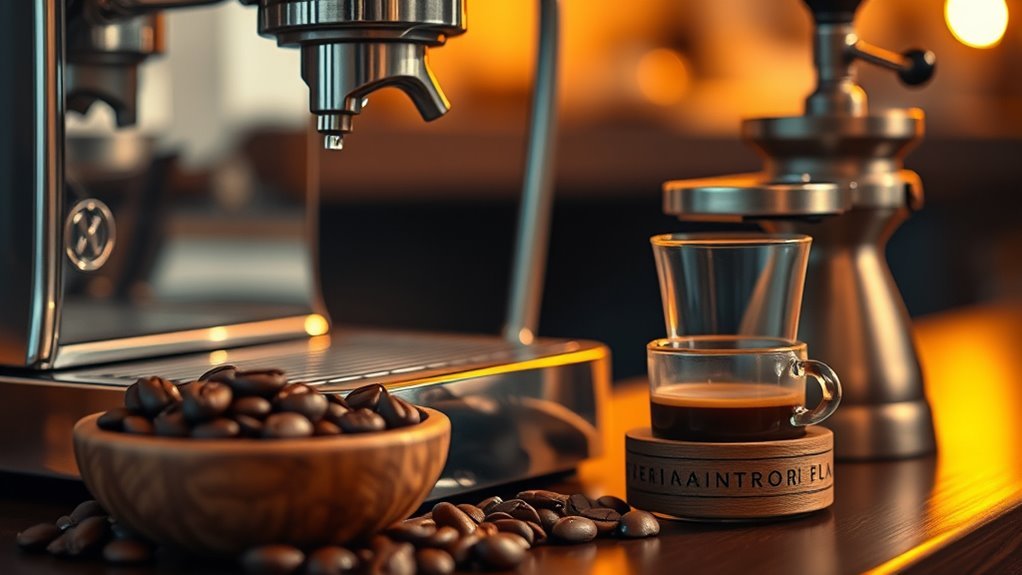
Since espresso demands precision, the freshness of your coffee and the quality of your grind are non-negotiable. Freshness factors like roast date and storage conditions directly affect flavor intensity and crema quality. You want beans roasted within the last two weeks, kept airtight away from light and heat. Grinding your beans just before brewing preserves essential oils that shape espresso’s bold character. Mastering grinding techniques is key; a consistent, fine grind guarantees peak extraction and balanced taste. Too coarse, and your shot will be weak; too fine, and it’ll taste bitter. Investing in a quality burr grinder lets you control particle size, releasing the freedom to tailor your espresso to your unique palate. Freshness and grinding aren’t just steps—they’re the foundation of your perfect shot.
Popular Coffee Bean Varieties for Espresso
You’ll find that choosing between Arabica and Robusta beans shapes your espresso’s flavor and crema markedly. Single-origin espresso beans offer unique, distinct profiles, while popular blends balance complexity and consistency for a reliable shot. Understanding these options helps you craft the perfect espresso tailored to your taste.
Arabica vs. Robusta
Although choosing the right coffee bean for espresso can be subjective, understanding the key differences between Arabica and Robusta beans will help you make an informed decision. These two varieties shape espresso origins and bean processing methods profoundly.
- Arabica beans offer a sweeter, more complex flavor with higher acidity, perfect if you crave nuanced profiles.
- Robusta beans pack a stronger, more bitter punch with double the caffeine, ideal for bold espresso lovers.
- Arabica thrives at higher altitudes, demanding careful processing to preserve delicate flavors.
- Robusta is hardier, easier to grow, and often used in blends to add crema and intensity.
Knowing these differences lets you choose beans that liberate your espresso experience, matching your exact taste and lifestyle.
Single-Origin Espresso Beans
When you explore single-origin espresso beans, you’re diving into a world where terroir plays an essential role in flavor. Single origin sourcing means each batch reflects the unique environmental factors of a specific region—altitude, soil, and climate—that shape the coffee’s profile. You’ll notice how regional characteristics like bright acidity from Ethiopian beans or chocolatey depth from Colombian varieties come through vividly in your espresso. This transparency offers you freedom to select beans that resonate with your palate and brewing style. Unlike blends, single-origin espresso beans deliver a distinct narrative in every cup, letting you experience coffee as a pure expression of place. Embracing these beans elevates your espresso journey, connecting you intimately with the land and craft behind every shot.
Popular Espresso Bean Blends
While single-origin beans offer a unique taste of place, popular espresso bean blends combine the best qualities of various varieties to create a balanced and complex flavor profile. When exploring espresso bean varieties, blends give you freedom to enjoy rich espresso flavor combinations tailored to your preference. Consider these popular blends:
- Classic Italian Blend – Combines Arabica and Robusta for boldness and crema.
- Latin American Blend – Features bright, fruity Arabicas for a lively cup.
- Dark Roast Blend – Mixes beans from different regions for smoky, intense notes.
- Specialty House Blend – Crafted to highlight floral and chocolate undertones with smooth body.
Tips for Storing Espresso Coffee Beans
Because espresso coffee beans are highly sensitive to air, moisture, heat, and light, proper storage is vital to preserve their rich flavor and aroma. You want to aim for ideal storage conditions that protect your beans from these damaging elements. Use an airtight container to maintain moisture control and prevent exposure to humidity, which can degrade freshness. Keep your beans in a cool, dark place—away from direct sunlight and heat sources like ovens or windowsills. Avoid storing them in the fridge or freezer, as fluctuating temperatures and condensation can harm the beans. By mastering these storage tips, you guarantee every shot of espresso bursts with vibrant flavor, giving you the freedom to enjoy barista-quality coffee anytime without compromise.
How to Choose Coffee Beans Based on Flavor Profiles
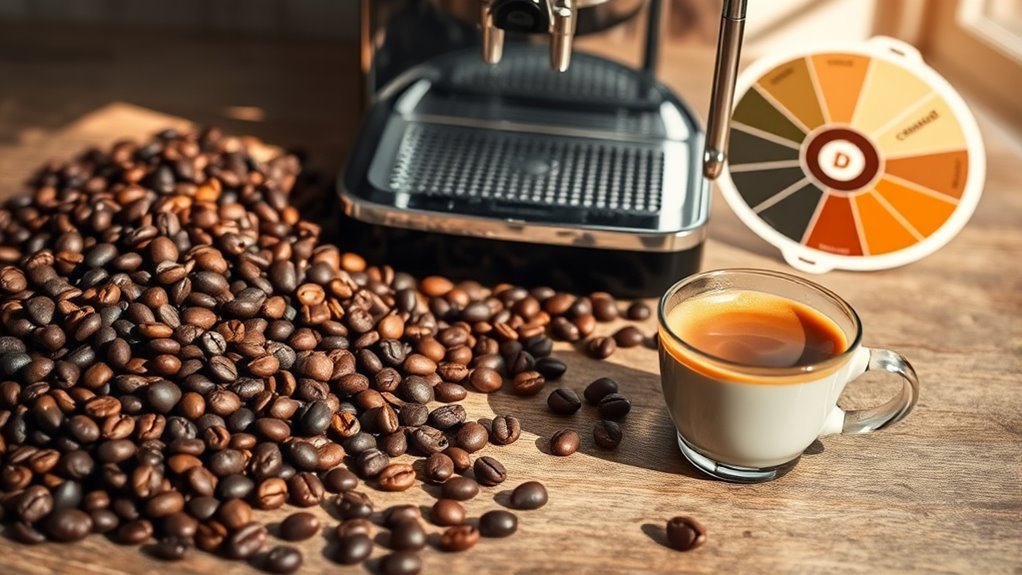
Proper storage keeps your espresso beans fresh, but choosing the right beans starts with understanding their flavor profiles. To truly enjoy freedom in your cup, consider these key factors:
Freshness begins with proper storage, but flavor freedom comes from knowing your beans’ profiles.
- Acidity – Higher acidity offers bright, lively notes; lower acidity provides a smoother, mellow taste.
- Body – Full-bodied beans deliver richness and depth, while lighter bodies feel delicate on the palate.
- Aroma – Floral, nutty, or fruity aromas hint at the coffee’s origin and roasting style.
- Roast Level – Dark roasts enhance boldness and bitterness; lighter roasts preserve unique flavor nuances.
Matching your beans to your preferred brewing techniques guarantees peak flavor enhancement. By selecting beans with profiles that excite your senses, you gain control over your espresso’s character, savoring freedom in every shot.
Frequently Asked Questions
What Is the Best Water Temperature for Brewing Espresso?
Wondering why water temperature matters so much when you brew espresso? You want it between 195°F and 205°F to extract the best flavors without bitterness. Remember, water quality is just as vital—clean, filtered water enhances taste. If your brewing time is off, even the perfect temperature won’t save you. So, control these variables carefully, and you’ll access that freedom to enjoy espresso exactly how you like it.
How Does Espresso Machine Pressure Affect Coffee Extraction?
You’ll find that pressure dynamics play an essential role in how your espresso machine extracts flavors. When pressure’s balanced just right, extraction efficiency peaks, pulling rich oils and nuanced aromas from the coffee grounds. Too little pressure, and your shot tastes weak; too much, and it becomes bitter. Mastering this pressure lets you access espresso’s full potential, giving you the freedom to craft intense, velvety shots that express your unique taste perfectly.
Can You Use Decaf Coffee Beans for Espresso?
Imagine the rich crema swirling atop your shot, a dance of boldness and depth. You can definitely use decaf coffee beans for espresso, though the decaf flavor tends to be milder, less intense than regular beans. While espresso strength might soften, the ritual’s essence remains. If you want freedom from caffeine but crave espresso’s charm, decaf lets you savor that robust, concentrated taste without compromise—just a gentler, nuanced experience.
How Often Should Espresso Machine Parts Be Cleaned?
You should stick to a regular cleaning frequency to keep your espresso machine in top shape—ideally, clean the portafilter and group head daily, and descale the machine every 1-3 months depending on usage and water hardness. Maintenance tips include wiping down steam wands after each use and backflushing with a detergent weekly. Staying on top of these tasks guarantees freedom from flavor buildup and mechanical issues, letting you enjoy perfect espresso without hassle.
What Is the Difference Between Espresso and Lungo?
You’ll notice espresso characteristics like its intense flavor and rich crema come from a short, concentrated shot. A lungo, on the other hand, involves a longer extraction time, using more water, which results in a milder, less concentrated cup. The lungo preparation lets you enjoy a bigger drink without losing espresso’s essence. It’s perfect if you want a freer, more extended coffee experience without sacrificing flavor depth.
